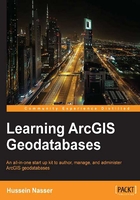
Preface
When the publisher asked me to write a book about ArcGIS geodatabases, I was glad to do so. I have been working with geodatabases since 2005 with eight different versions of ArcGIS starting from Version 9.1; writing this title was a thrill for me. When the publisher mentioned that they need it to be a short book, based on the research done by their strategy team, I had to put in an extra effort and make tough decisions on what to include in this book and what to discard, without compromising on the quality of the content. What you are holding in your hands now is the essence of that work.
Learning ArcGIS Geodatabases was designed for those who want to start using the ArcGIS technology or those who have been using it and want to learn more about geodatabases. There are going to be three themes that will run throughout the book. The first theme covers Chapter 1, Authoring Geodatabases, and Chapter 2, Working with Geodatabase Datasets, and it is tailored for beginners and readers who are not familiar with ArcGIS geodatabases. It teaches readers how to author geodatabases and how to create and work with different datasets in their geodatabase. The second theme covers Chapter 3, Modeling Geodatabases, and Chapter 4, Optimizing Geodatabases, and it is targeted for intermediate users. It caters to those who know about geodatabases already and want to run them better. It is an excellent chapter for those who want to remodel their existing geodatabase and make it more efficient and cost less to maintain. They are also presented with new tools to help them tune and optimize their geodatabase. The last theme covers the last two chapters, Chapters 5, Programming Geodatabases, and Chapter 6, Enterprise Geodatabases, and it is designed for advanced readers. It caters to those who want to excel in using ArcGIS geodatabases with programming and script writing to manage and administer their geodatabase. They want to upgrade and use enterprise geodatabases instead of using simple file geodatabases so they can get the benefits of the multiuser environment.
All three themes come under the umbrella of a project called Bestaurants, where the reader helps a client in Belize, a country on the northeastern coast of Central America. The reader will help improve the Bestaurants project by designing a geodatabase to visualize the best restaurants, diners, cafes, and so on in Belize. With each chapter, the Bestaurants client will ask for new requirements that the reader will try to implement by the end of the chapter. The reader will author the geodatabase, tune, optimize, and create additional datasets, and so much more as the requirements of the client increase.